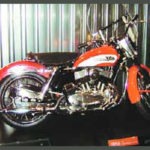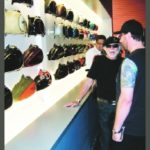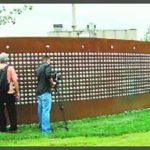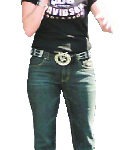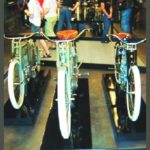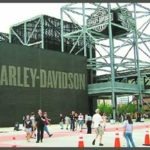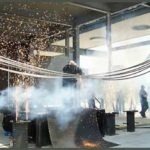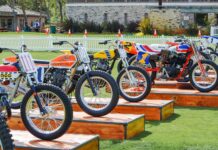Fire it up
105 years of history on display
Milwaukee, July 11–12—Harley-Davidson has added a new ride to everyone’s itinerary, and for this one, the destination may be more exciting than the journey. After more than two years of construction, the Harley-Davidson Museum is now open to the public. This is a final step in a project that company officials have been planning for many years.
Since 1915, company officials have pulled one bike out of production or taken back a bike that had been ridden and kept it in storage. In addition, The Motor Company purchased bikes from earlier years to have a complete history. The company has had a museum as part of its York, Pennsylvania, operation for many years and it was quite nice. But the new museum sets a higher standard.
My girlfriend Kris and I were lucky enough to attend the media day event on Friday, the day before the official grand opening, and it was great. Every museum obviously tells a story and the story starts before you even get inside. The museum is on converted public land that had been a brownfield site. The complex has three massive buildings: One holds the exhibits, one has food service and a store, and one houses the Harley archives. Harley and Pentagram Architects of New York City wanted a building that would reflect the character and strength of the Harley rider, the employees of the company and the industrial history of the birthplace of The Motor Company. You’re greeted with quite a visual as you enter the grounds and see the striking black buildings and the 1,200 tons of steel beams used as support.
One of the first visual effects you encounter is the 23,000-pound Harley-Davidson monolith—designed by Willie G.—hanging above the buildings. When lit up at night, it serves as a guidepost for anyone looking for the museum. The next item you see is the giant “Harley-Davidson” spelled out on the brick wall of the exhibit hall. When this was designed, a layout was prepared listing each of the 4,700 bricks needed for the wall. An employee of the subcontractor, Tom Wendt, a Harley rider, took specific bricks based on their location in the sign and cut the individual brick to show the curves needed to spell out the name in Harley fashion. True to masonry custom, he signed his name to the back of the last brick on the upper right hand of the building.
Between the buildings and the Menomonee River bordering the museum is a bronze statue showing a hill climber on his way to the top. The statue was created by Jeff Decker and donated by Nancy and Willie G. Davidson. The details in the bike and on the rider’s face speak volumes about the sport. Look closely and you will see Willie G.’s name carved on the engine. Outside the museum is a separate area with engraved rivets that individuals and groups have purchased to express their own personal thoughts on the riding experience.
Stacy Schiesl, the museum director, introduced Jim Biber, the lead architect, who was on hand to celebrate and answer questions along with other individuals involved with the project, including the company master chef, Robin Rosenberg. Robin led us through the menu for the day, which included baby back ribs, several choices of Wisconsin’s famous brats, a delicious corn bread, salads with local greens and grains, baked beans specially cooked with the ribs, and a peach cobbler for dessert. While this was great for the media crowd, the nice thing about the menu is that it is also available on a regular basis in Motor, the museum restaurant. Another restaurant, Café Racer, serves breakfast, lunch, and light dinner.
A ride through the past
Then it was time for the main event: a guided tour through the exhibits. We were separated into three small groups with tour guides. We were fortunate to have Bill Jackson, the manager of the archives, as one of our guides. His knowledge of the company’s history greatly added to our enjoyment of the exhibits. The tour actually begins on the upper level and as you enter you see a long line of bikes from the company’s past up to 1939, starting with a 1909, 1906 and a 1911. Surrounding the line of bikes are several rooms that depict the history of the company. If you go to the right you will find Serial Number 1, the oldest Harley in existence, along with stories about the bikes and the company.
The engine room is to the left and you are first greeted by an expanded view of a bike. It is set up so that when you first see it, it appears as a completed bike, but then you notice that it is actually several bike components, displayed so you can see what parts go together. There is a wall with several engines, past and current, with several interactive displays that will keep kids (both big and small) busy. A special room is set up depicting Clubs and Competition, with a board track on display along with some of the history of that exciting time when racers would hit 100 mph on a curved track with no brakes. In addition, several displays of old riding gear are included. Further down the room is a poster wall featuring many of the old advertising posters used in the popular culture of the day.
When One of my favorite areas is the tank wall, that has over 100 tanks on display. Harley considers the tank to be one of the most expressive parts of a cycle. Willie G. Davidson personally selected the tanks for the wall, and it’s an impressive sight.
you look down from the upper level to the lower level you will see what Harley calls “The Bridge.” This display honors the “jumpers” in the bike world with a replica of Evel Knievel’s XR-750 Wembley jump bike along with other high-risk bikes.
The tour continues on the lower level with a display of bikes from 1940 to present. One of the more popular areas of the museum is the custom culture exhibit on this floor. Displays of some custom bikes from the past are on view including the King Kong bike that has two Knucklehead motors in tandem, and the Rhinestone Harley. Many museums display articles owned by a king and the Harley Museum is no different. This bike happens to have been owed by the King of Rock ’n’ Roll, Elvis Presley. Included with the bike is the paperwork for the 1956 KH model he purchased shortly before he became famous. The bike’s price was a little over $900. Also in this area are several displays of articles from the ’50s and ’60s that show how the biker was presented as a misfit in the community, including video clips from Easy Rider and other films of that era.
A display from the design lab lets you see some of the processes used to develop the next great idea from Harley. At the end of the room is The Experience Gallery, with several different models on display for visitors to sit on while they watch films of riders gliding down the road. If you come to the museum and aren’t lucky enough to have the manager of archives as a guide, you can rent an audio self-guided tour for $5.
After the tour it was time to head to The Shop to pick up some unique merchandise available only at the museum. The next day was the grand opening and we did not want to miss this opportunity.
Ribbon cutting, Harley-style
Saturday started as a beautiful warm day and it looked like we lucked out, considering all the weather problems the area has had in the past few months. We arrived at the museum about an hour prior to the grand opening, and already the parking lot was full of bikes. There is ample free parking on the grounds for autos and bikes so bring as many friends as you want.
Stacy Schiesl once again acted as the master of ceremonies. The event was held outdoors so everyone could be accommodated, and it began with a cannon blast to let everyone know we were starting. AJ from the band Northern Room started off with a terrific guitar and vocal rendition of “The Star Spangled Banner” and then Stacy introduced several speakers including Jim Ziemer, the company president and CEO, who delighted the crowd with the news that he was finally going to get a tattoo. Then came Jim Doyle, the governor of Wisconsin who later that day was going to attend the National Governors’ Conference with something new to brag about for his state. The chief executive of the county, the mayor of Milwaukee, and the area aldermen joined in with praise for everyone involved with the project, along with their appreciation for all the riders involved. Each also promised that his speech would be the shortest. Willie G. Davidson was the final speaker and was roundly cheered as soon as he stepped up to the podium.
After the speeches it was time to cut the ribbon, but in true Harley style, this was no ordinary ribbon. It was a 300-foot primary chain that had to be cut with a torch, much to the delight of the crowd. Tours began immediately following the ceremonies. If you were not on a tour you could watch the Milwaukee Fire Department boat’s water display on the river that fronts the museum. Even Willie G. was taking a tour and I spotted him explaining several of the exhibits to enthusiasts. Attractions outside the Museum included food booths, bands, and local radio station interviews. You could even watch Jim Ziemer actually get his tattoo later in the day. (www.h-dmuseum.com).


